Surface Subdivision
When rendering, objects are subdivided into lines and polygons, forming an approximation of the object. The precision of the subdivision can be specified by adding special characters to the front of the name of the object in the Browser, or via the Surface Subdivision pop-up menu in the Rendering Settings. Note that added control points to a line object will change the way it is subdivided. If you copy a line object and add control points to one of the lines, the subdivision will not match. In order to have matching subdivision, the control points must be added to the line before making the copy, so that the same number of control points are in the same positions. Each type of object is subdivided as follows:
Line Objects
Approximated by subdividing into straight lines. The line between two adjacent control points will be subdivided into straight lines based on the specified precision.
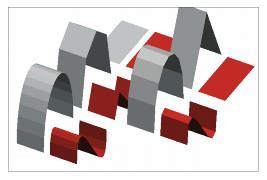
This example shows several extruded open lines consisting of two control points each. The red shapes were subdivided using low precision, resulting in a bad approximation.
Disks
When rendering with ray tracing and not using radiosity or shadow maps, disks are not subdivided into polygons, and a smooth outline is always rendered.
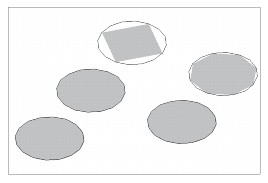
This example shows disk subdivision with shading on. From upper left: no subdivision or using the "@" character; Coarse or using the ">" character; Regular, Fine or using the "<" character; and Very Fine or using the "<<" characters.
Spheres
When rendering with ray tracing and not using radiosity or shadow maps, disks are not subdivided into polygons, and a smooth outline is always rendered.
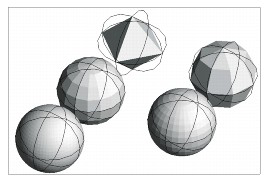
Subdivided Disks
Revolved Solids
Revolved surfaces are approximated as polygons.
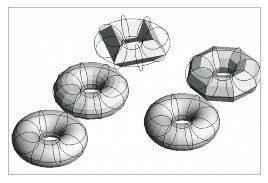
Subdivided revolved solids
Curved surfaces
Approximated by subdividing into quadrilaterals or triangles. If the area of a quadrilaterial is small, it will be subdivided into triangles. Curved surfaces with 4 control points are subdivided into quadrilaterals or triangles using the specified precision.
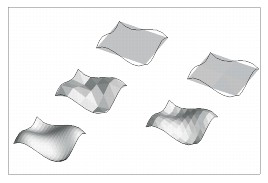
Subdivided curved surfaces
Polygon Mesh Round Edge
The degree to which edges are rounded is specified by the Subdivision Surface settings in the Display group of the Object Info Window for polygon meshes. The Roundness Type can set to None, Catmull-Clark, or Doo-Sabin, and the Weight slider specifies the amount of rounding.

Round Edge Weight slider set to 0.1

Round Edge Weight slider set to 0.5
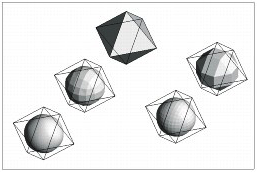
Round Edge Weight slider set to 1
These figures show the subdivision when Round Edge is applied.
Levels of Subdivision with the Surface Subdivision Pop-up Menu
The level of subdivision determined by the Surface Subdivision pop-up menu in the Rendering Settings is as follows:
| No Subdivision |
Coarse |
Regular |
Fine |
Very Fine |
|
|---|---|---|---|---|---|
| Between 2 points on a line object |
1 |
2 |
4 |
8 |
16 |
| Disk |
Square |
Regular octagon (8 sides) |
Regular polygon (16 sides) |
Regular polygon (32 sides) |
Regular polygon (64 sides) |
| Sphere |
Regular octahedron (8 sides) |
32-sided polyhedron |
128-sided polyhedron |
512-sided polyhedron |
2048-sided polyhedron |
| Revolved face of |
Square |
Regular octagon (8 sides) |
Regular polygon (16 sides) |
Regular polygon (32 sides) |
Regular polygon (64 sides) |
| Curved surface with 4 points |
1 quadrilateral or 2 triangles |
Minimum Maximum |
Minimum Maximum |
Minimum Maximum |
Minimum Maximum |
| Polygon |
No Subdivision |
No Subdivision |
No Subdivision |
No Subdivision |
No Subdivision |
Specifying Surface Subdivision Using Characters
Surface subdivision characters can be used in combination with the Surface Subdivision pop-up menu setting. For example, if the Surface Subdivision pop-up menu is set to Coarse, and an object is prefaced with the "<<" characters in the Browser, the object will be subdivided two levels finer than Coarse. If the "@" character is included in an object's name, the "@" character takes precedence, and no subdivision is done.
- "@" character: no subdivision
- "<" character: the object is subdivided one level finer than that specified in the Surface Subdivision pop-up menu
- ">" character: the object is subdivided one level coarser than that specified in the Surface Subdivision pop-up menu